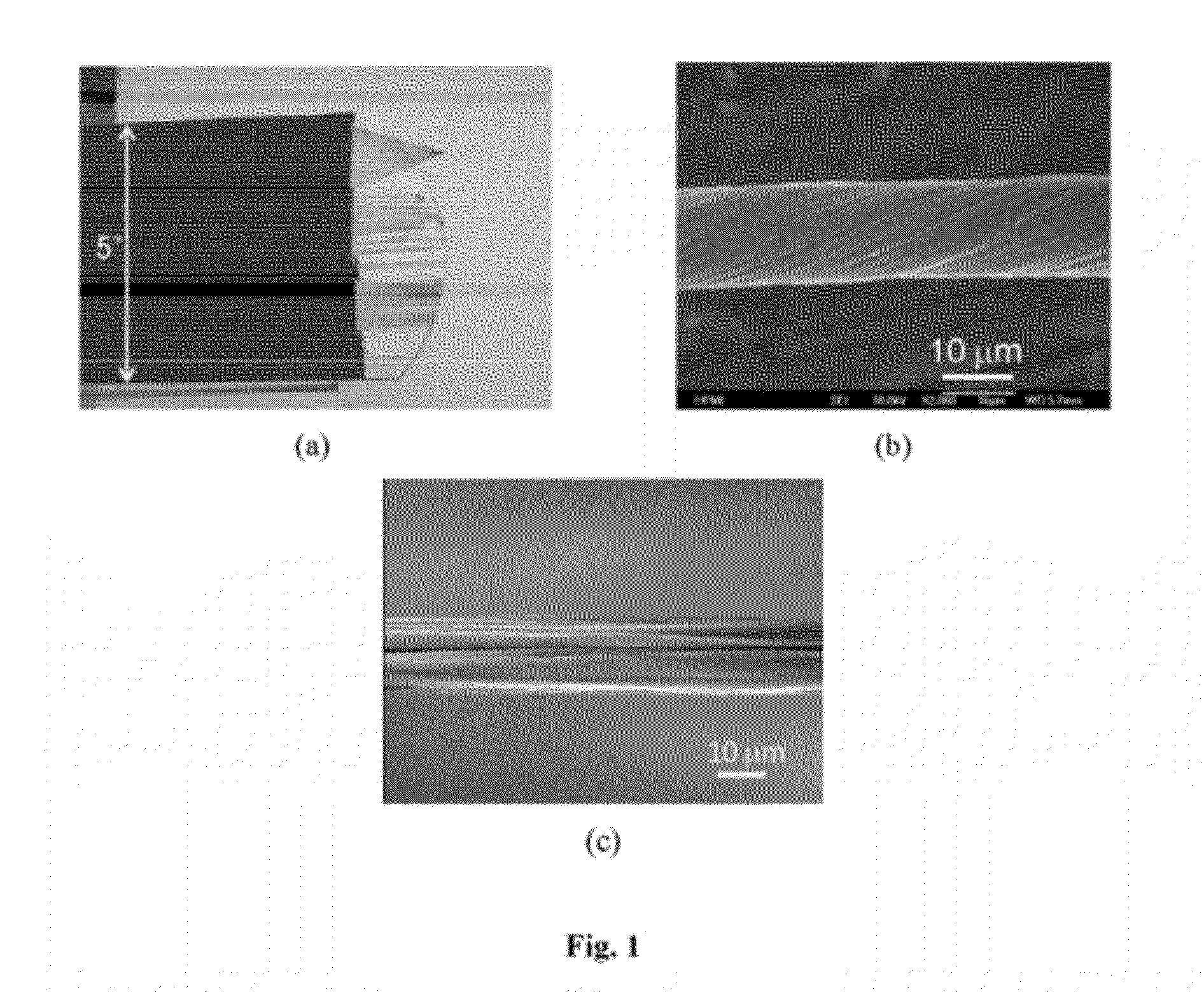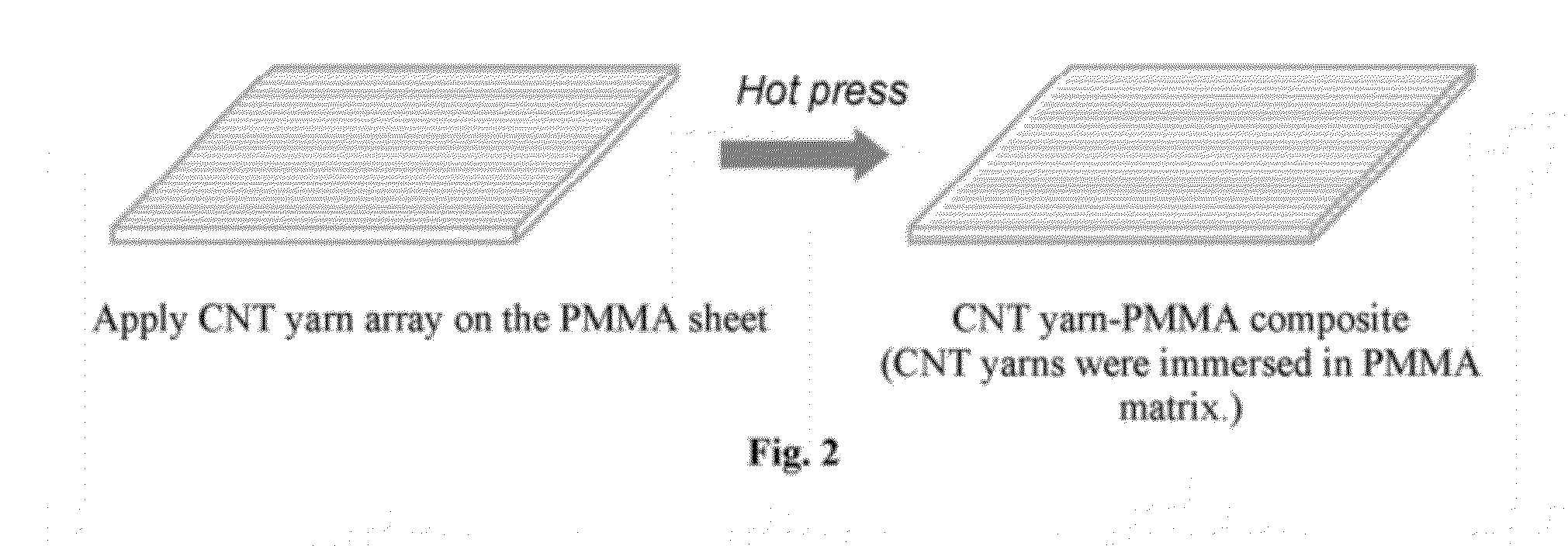Composite Materials Reinforced with Carbon Nanotube Yarns
a technology of carbon nanotubes and composite materials, which is applied in the direction of non-conductive materials with dispersed conductive materials, textiles and papermaking, woodworking apparatus, etc., can solve the problems of composite materials produced by these methods that are generally not transparent, composite materials that are relatively small in the reinforcement effect of cnts, and composite materials that lose transparency
- Summary
- Abstract
- Description
- Claims
- Application Information
AI Technical Summary
Benefits of technology
Problems solved by technology
Method used
Image
Examples
example 1
Fabricating Polymer / CNT-Yarn Composite Materials
[0050]In this particular example, poly(methyl methacrylate) (PMMA) was used as the matrix material. PMMA is a transparent thermoplastic, which is often used as a light or shatter-resistant alternative to glass. The CNTs used for making CNT yarns in this example were multi-walled carbon nanotubes with a ˜10 nm diameter, and a length of 300-500 μm. The CNT yarns had a diameter of about 15 μm.
[0051]The PMMA / CNT-yarn composite materials in this example were made by applying CNT yarns on top of a PMMA sheet, before placing the materials into a mold and then a hot press apparatus. The materials were heated, without applying pressure, until the plates reached the setting temperature. The setting temperature is usually the melting point of the plastic.
[0052]Then, 1 metric ton of pressure was applied for several minutes. The hot press was then shut off to cool down, under pressure, until the temperature was less than the glass transition temper...
example 2
CNT Yarns
[0056]The engineering stress-strain behavior of PMMA sheet and CNT yarns was tested. The tensile strength and strain of the PMMA sheet was ˜40 MPa and 2.7%, respectively. The pristine CNT yarn was about 10 times stronger and had a strain that was 3.5 times longer than that of the PMMA sheet. This suggested that CNT yarn may be used to reinforce a PMMA matrix. When a pristine yarn was embedded in the melting PMMA and then pulled out, a PMMA infiltrated CNT yarn was obtained. Through this process, PMMA was at least partially infiltrated into the CNT yarn, and formed a PMMA-coated CNT yarn after cooling down.
[0057]FIG. 4 shows that the mechanical properties of the yarn were enhanced. This was because the PMMA infiltration helped the formation of cross-links inside the yarn to prevent the sliding between CNTs under loading. When the CNT yarns were embedded into PMMA matrix, the PMMA infiltrated into CNT yarns, at least on the skin of yarns. This means that CNT yarns as filler i...
example 3
CNT Content Control and Evaluation
[0058]CNT content in the composite materials disclosed herein was controlled by the size and the number of the CNT yarns (namely the area density of the CNT yarn array). Thermogravimetric analysis (TGA) was performed to assess the thermal stability of PMMA and PMMA / CNT-yarn composites, and the weight percentage of CNTs in the composites. TGA was conducted on PMMA and PMMA / CNT composites in nitrogen from 25° C. to 450° C., and then in air from 450° C. to 800° C. at a heating rate of 10° C. / min. The gas flow rate was 60 mL / min. The TGA curves are shown in FIG. 5.
[0059]From the TGA curves it can be seen that the samples' weight loss could be divided into two parts. The first weight loss stage was attributed to the loss of PMMA, and the second one to the loss of CNTs. The CNT content in the composite was obtained from the weight loss at around 500° C. The decomposition temperatures of PMMA and CNTs in composites were determined by reading the peak posit...
PUM
| Property | Measurement | Unit |
|---|---|---|
| diameter | aaaaa | aaaaa |
| transparency | aaaaa | aaaaa |
| length | aaaaa | aaaaa |
Abstract
Description
Claims
Application Information
 Login to View More
Login to View More - R&D
- Intellectual Property
- Life Sciences
- Materials
- Tech Scout
- Unparalleled Data Quality
- Higher Quality Content
- 60% Fewer Hallucinations
Browse by: Latest US Patents, China's latest patents, Technical Efficacy Thesaurus, Application Domain, Technology Topic, Popular Technical Reports.
© 2025 PatSnap. All rights reserved.Legal|Privacy policy|Modern Slavery Act Transparency Statement|Sitemap|About US| Contact US: help@patsnap.com



